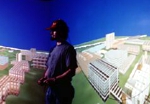
Monday, March 5th, 2012
Every ten years or so, we achieve a technological breakthrough that drives innovation for the next decade. We are coming out of the age of emergence of the Internet, which has seen this enabling technology move from novel to ubiquitous. By 2010, cell phones and smart phones were on the path to becoming standard, with

Friday, November 18th, 2011
I recently had the good fortune to attend a GeoDesign workshop presented by Bill Miller, who is the Director of GeoDesign Services at Esri, and one of the people credited with coining the term. It was a fascinating morning, and it was a reflection of how important this topic is becoming that Alex Miller, president

Wednesday, October 19th, 2011
The LAS format – introduced in 2004 by the ASPRS – has become the de-facto international standard for storing and exchanging point data acquired by airborne LIDAR scanners. It has wide acceptance and can be read and written by almost any LIDAR processing software. There now exist Exabytes of LIDAR that can easily be exchanged

Sunday, September 11th, 2011
GIS has its roots in what a geographer or cartographer might call “small-scale” information, information primarily related to issues of land management and the environment. In the early days, there were many competing acronyms for what is now known as GIS, such as Land Information Systems (LIS), and Facility Information or Facility Management Systems (FMS).

Wednesday, August 17th, 2011
The concept of geolocation privacy is now receiving a good deal of attention in the United States. For example, nine bills are being considered on Capitol Hill that would would regulate the collection, use and/or transfer of geolocation information. Many of the bills include geolocation as part of larger privacy bills and treat an individual’s

Tuesday, August 16th, 2011
Not that long ago, I considered “web mapping” an advanced topic, best left to be taught in a senior GIS course. While that can still be the case, depending on how it is defined, the fact is that creating a map of your own data on a web page has become something anyone can do

Friday, July 22nd, 2011
Building Information Modeling (BIM) is replacing Computer Aided Drafting (CAD) as the tool in which building designs are created. BIM is a graphic and data model of a building prepared by designers, enhanced by builders, and can be used by owners. BIM enables all parties involved in a project to communicate in a more collaborative

Tuesday, June 28th, 2011
The assignment of novel educational and research tasks brings the certainty that Europeans will be part of a new era of the utilization of “Culture”: an era with broader exploration ambitions in “research and education” for the CITHM (Culture, Innovation & Technologies for Heritage Management) in Mediterranean Regions. “The Risk of Education explores what is
Sunday, May 15th, 2011
There are many people who don’t consider themselves geospatial professionals, but instead are casual GIS users. They probably don’t go to GIS conferences, or keep up with everything that’s happening in the field, and yet I’ll bet they perform a sizeable proportion of all of the mapping and spatial analysis tasks that are done on
Monday, April 25th, 2011
A recent Perspectives column in V1 Magazine noted the potential for using intelligent 3D city models for airports. At Galdos, we believe this is definitely true, and not only for airports, but for many other types of transportation infrastructure including rail stations, and seaport facilities. Furthermore, suitable city models can be used to provide effective